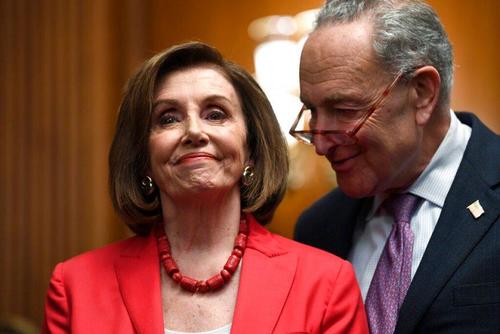Here Comes “Budget Reconciliation”: What Happens Next
On Monday, congressional Democrats released a budget resolution for FY2021 that, when passed, will give them the option to pass coronavirus relief legislation through the reconciliation process with a simple majority in the Senate without Republican support. After President Biden met with ten moderate Republican senators, the White House quickly signaled its support for passing COVID-relief through the budget reconciliation process, which appears set to begin as soon as today.
- *SENATE TO VOTE TODAY TO BEGIN BUDGET RESOLUTION DEBATE: SCHUMER
If – or rather when – it is approved, Goldman writes this process would pose upside risk to its $1.1 trillion (5% of GDP) assumption for additional fiscal stimulus, although it does not see it rising as high as the initial Biden proposal of $1.9 trillion.
Here is a breakdown of what is coming next, courtesy of Goldman’s Alec Philips
- On Feb 1, Congressional Democrats released a FY2021 budget resolution. The resolution itself is a non-binding document, but it would give them the option to pass coronavirus relief legislation through the reconciliation process with only a simple majority in the Senate, i.e., without Republican votes. The key detail in this document is that it instructs the relevant congressional committees to increase the deficit by up to $1.9 trillion, the same amount that President Biden’s American Rescue Plan calls for. This figure, if approved, would set the upper limit on the cost of the next round of legislation.
- Following a meeting with ten moderate Republican senators (the same number required to pass legislation with the 60-vote bipartisan threshold), the White House quickly signaled that it supports using the budget reconciliation process to pass the next round of coronavirus relief legislation, rather than passing a bill through regular order, which would require bipartisan support.
- These developments suggest “upside risk” to Goldman’s $1.1 trillion assumption for additional fiscal stimulus, though the final number will be lower than the $1.9 trillion envisioned in the budget resolution, for two reasons. First, with very narrow majorities in both chambers of Congress, Democrats need virtually every member to support the resolution and the bill that follows, and some centrist members have raised issues with the White House proposal’s $1.9 trillion cost. Second, Senate rules and precedents regarding reconciliation could pose obstacles to aspects of the proposal, particularly discretionary spending measures that could account for several hundred billion dollars of the Biden proposal that falls in this category.
- House and Senate Democratic leaders have signaled their intent to pass the budget resolution this week. If they do, this would allow the relevant committees to develop the detailed legislation over the next few weeks, with the expectation of passage later this month or in early March, ahead of the March 14 expiration of enhanced unemployment benefits.
Tyler Durden
Tue, 02/02/2021 – 13:00
via ZeroHedge News https://ift.tt/2NVtLVj Tyler Durden
